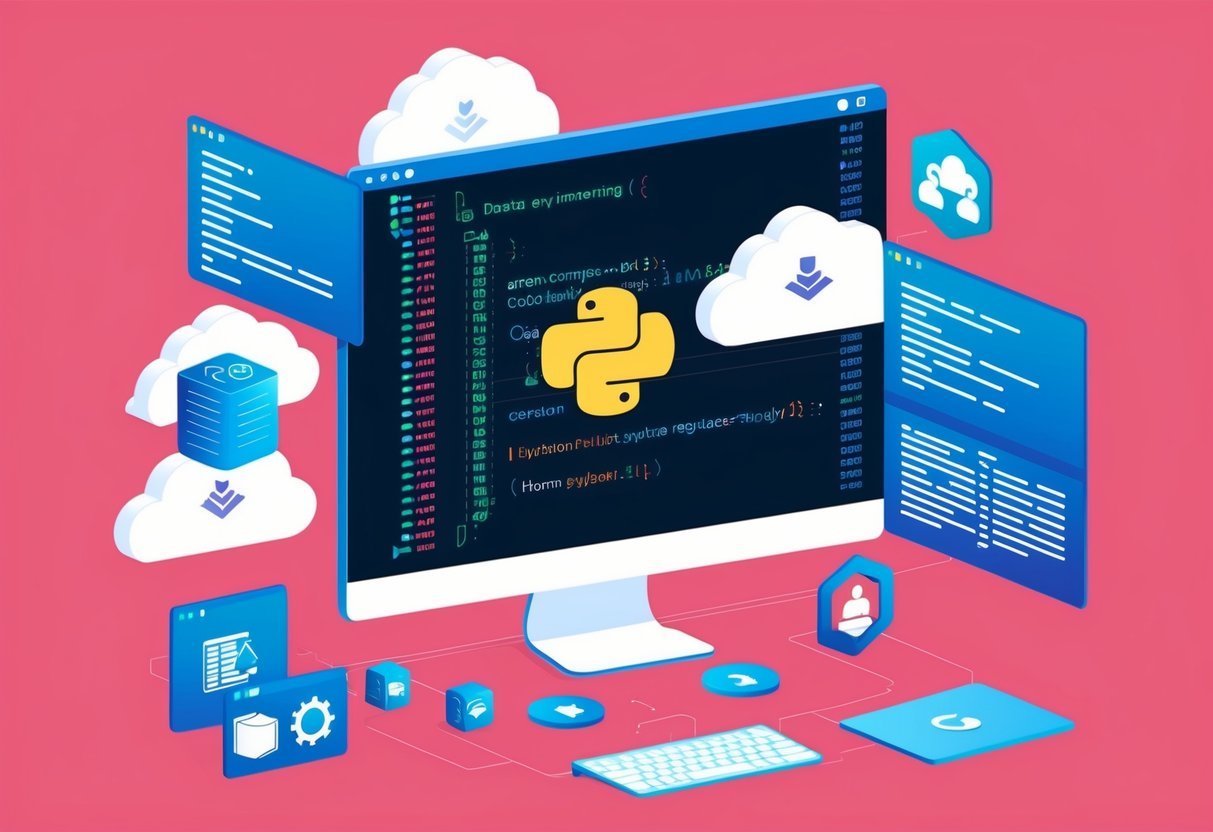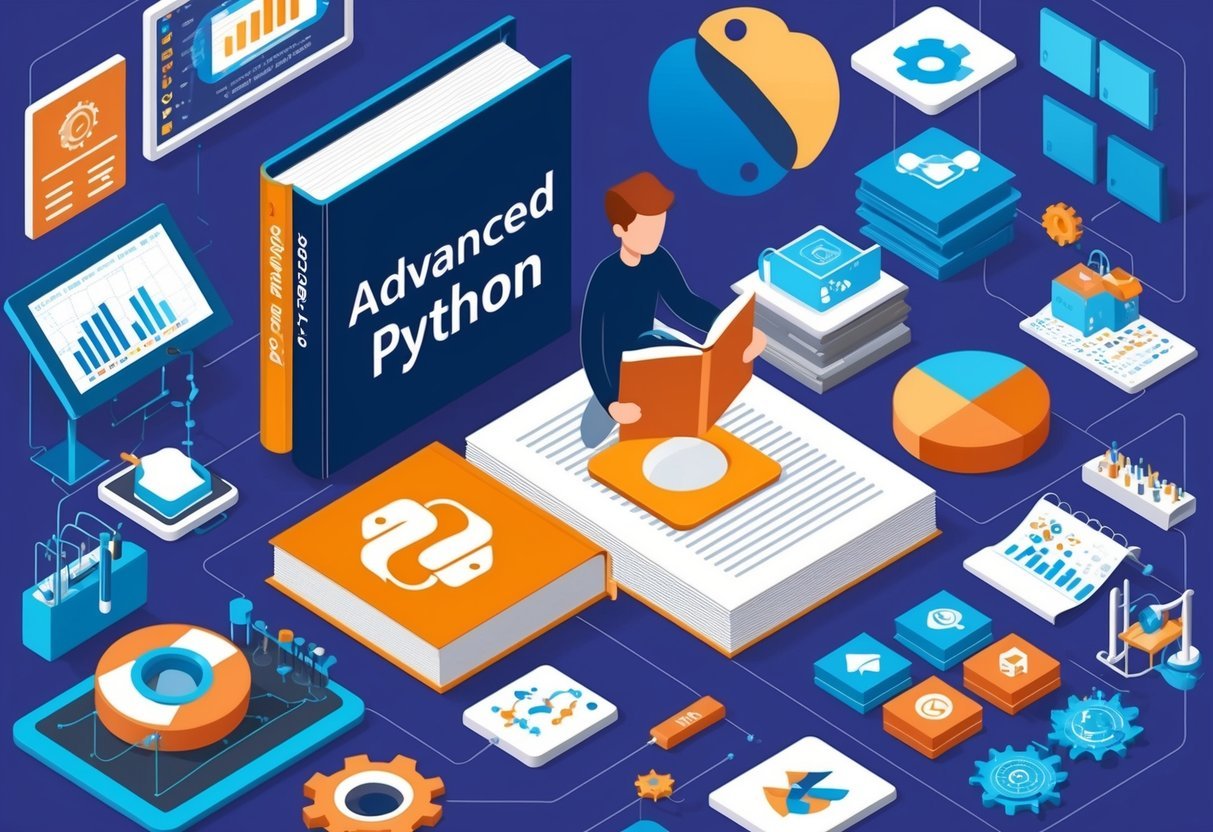Python Fundamentals
Understanding Python’s fundamentals is essential for mastering more advanced data engineering tasks.
Key components include basic syntax, managing data using variables, decision-making with control structures, and working with essential collections like lists and dictionaries.
Language Basics
Python is known for its clean and readable syntax, making it a popular choice for beginners and experts alike. The language uses indentation to define the structure of the code, which is crucial for functions, loops, and conditionals.
Learning how to implement these elements correctly is foundational.
Comments are also necessary for explaining code sections. They are added with the # symbol, helping programmers understand and maintain the code over time.
The simplicity of Python syntax reduces errors and enhances code readability, a significant advantage in data engineering where complexity is common.
Consistent practice with foundational syntax will improve fluency and efficiency in writing Python code.
Variables and Data Types
Variables in Python serve as containers for storing data values. They can hold various data types, such as integers, floats, and strings, each suited for specific roles in data operations.
Variable Declaration is simple and doesn’t require explicit type definition. For instance, name = "Data Engineer" creates a string, while age = 30 creates an integer. This flexibility encourages experimentation and ease of use.
Understanding data types like integers, floats, and strings is vital.
Lists are used for holding ordered collections of items, whereas dictionaries store key-value pairs. These structures allow efficient data manipulation, which is crucial in building and managing data pipelines.
Control Structures
Control structures are essential for directing the flow of a Python program.
Conditional statements, such as if, elif, and else, allow programs to make decisions based on conditions.
Loops, specifically for and while loops, are utilized to repeat actions until certain criteria are met. This is particularly useful for processing large data sets in data engineering.
Mastering these control structures allows programmers to automate and streamline repetitive tasks, enhancing productivity.
Control structures are central for developing complex algorithms that perform a wide range of data processing tasks efficiently.
Python Collections
Python collections are versatile tools for storing and manipulating groups of data. Key collections include lists, tuples, sets, and dictionaries, each with unique characteristics.
- Lists are ordered and mutable, making them ideal for dynamic collections.
- Tuples are ordered and immutable, preserving data integrity.
- Sets store unordered, unique items, useful for removing duplicates.
- Dictionaries offer key-value pairing, which is handy for rapid data retrieval.
Understanding these collections allows engineers to handle complex data coordination.
Knowing when and how to use each type ensures optimized and efficient code when dealing with large volumes of data. Each collection type has its specific functions, making them versatile for various tasks in data processing and management.
Object-Oriented Programming in Python
Object-oriented programming (OOP) is a core aspect of Python programming that enhances coding skills for data engineering. Key concepts include defining classes, utilizing inheritance and polymorphism, and implementing encapsulation and abstraction.
Defining Classes
In Python programming, classes serve as blueprints for creating objects. They encapsulate both data (attributes) and functions (methods) that operate on that data. This tool allows developers to structure their code by partitioning data and behavior.
A basic class structure includes a __init__ method, which initializes the object’s attributes. For instance, defining a class Car involves specifying its make, model, and year. The __init__ method then sets these attributes when a new Car object is instantiated.
Effective use of classes can simplify code management and improve clarity.
Inheritance and Polymorphism
Inheritance enables a class to derive from another, promoting code reuse and efficiency. In Python, a child class inherits attributes and methods from a parent class, while also introducing unique features.
For example, a Vehicle class might serve as a parent to Car and Bike, allowing shared properties like speed, yet offering specific functions such as honk() for Car. Polymorphism allows these classes to redefine methods as necessary, enabling flexible and dynamic code behavior.
Polymorphism further ensures that a single interface can handle different data types, adding versatility to code by allowing objects to be treated as instances of their parent class.
Encapsulation and Abstraction
Encapsulation in coding skills emphasizes restricting direct access to certain attributes and methods to ensure controlled interaction. In Python, this is often done using private variables, marked by a leading underscore (e.g., _engine). Encapsulation preserves the internal state of an object, safeguarding it against unauthorized modification.
Abstraction simplifies complexity by hiding unnecessary details from the user. Through abstraction, Python developers expose only relevant parts of an object to the outside world. This is typically achieved by defining public methods that provide an interface to interact with data.
Together, encapsulation and abstraction enhance the security and usability of Python programs.
Advanced Python Libraries
Advanced Python libraries play a crucial role in data engineering tasks, facilitating efficient data handling and numerical computations. Among these, Pandas and NumPy are renowned for their capabilities and ease of use.
Data Handling With Pandas
Pandas is a powerful tool for data manipulation and analysis. It is especially useful for handling structured data. It provides data structures like DataFrames that allow users to manipulate data effortlessly. With its various functionalities, Pandas simplifies tasks such as data cleaning, filtering, and transformation.
Data engineers often use Pandas for tasks involving large datasets. The library supports operations like grouping and merging data, which are essential for preparing datasets for analysis. Its intuitive syntax makes it accessible for quick explorations and in-depth data investigations.
Pandas also integrates well with other libraries used in data engineering, offering compatibility that enhances its utility. Whether aggregating data or conducting exploratory data analysis, Pandas remains a preferred choice for its robust performance.
Numerical Computing With NumPy
NumPy is a foundational library in Python, crucial for numerical computing. It is particularly noted for its array objects that allow efficient storage and manipulation of data. NumPy arrays are faster and more compact than Python lists, making them ideal for numerical tasks.
Data engineers use NumPy for performing complex mathematical operations. Its functions enable high-speed computations required for large-scale data engineering tasks. This is achieved by providing built-in support for large matrices and multidimensional data, which are common in various applications.
The library works seamlessly with other Python libraries, forming the backbone for advanced operations in data engineering and scientific computing. With tools for linear algebra, random number generation, and more, NumPy is indispensable for engineers who require precise and quick computational solutions.
Data Engineering Essentials

Data engineering involves working with various technologies and tools to manage and process data efficiently. This includes handling databases, creating data pipelines, and performing file operations like reading and writing data.
Working With Databases
In data engineering, databases are crucial for storing and retrieving large amounts of data. Engineers must understand SQL to interact with relational databases and NoSQL for non-relational data storage. These skills help in executing complex queries, data modeling, and indexing.
Databases like MySQL, PostgreSQL, and MongoDB provide versatile options for different data operations. Knowledge of database management systems (DBMS) is also important for ensuring data integrity, security, and performance optimization.
Data Pipelines Fundamentals
A data pipeline is a series of processes used to automate the flow and transformation of data. Understanding ETL (Extract, Transform, Load) is vital for designing effective pipelines.
Tools like Apache Spark and Apache Airflow help in creating scalable and efficient pipelines. Engineers should be proficient in handling big data platforms like Hadoop.
Pipelines enable the processing of real-time data, which is essential for timely insights and decision-making. Engineers must also focus on error handling and monitoring to maintain data quality.
File Handling and I/O Operations
File handling is essential for working with different data formats such as JSON and CSV. Engineers need to handle files for both input and output operations.
They often use Python for its libraries like pandas and NumPy, which simplify data manipulation. Understanding file paths, directories, and how to handle large files efficiently is important.
Techniques like file compression and buffering improve performance and resource management. These skills are critical when dealing with massive datasets typical in large-scale data engineering projects.
Building and Maintaining Data Pipelines
Data pipelines are essential for moving data efficiently across systems. They involve extracting data, transforming it into useful formats, and loading it where needed. This section covers key areas in managing these pipelines: ETL processes, data transformation techniques, and pipeline orchestration.
ETL Processes
ETL stands for Extract, Transform, Load. It is a core component of data pipelines.
The extraction phase pulls data from various sources, such as databases or APIs. This raw data can often be messy or incomplete.
During transformation, the data is cleaned, formatted, and modified to suit specific needs or standards.
As data engineers transform data, they often use programming languages like Python or SQL. These languages help to automate transformations and ensure data quality.
Finally, the load process involves importing the transformed data into a destination system. This could be a data warehouse or an analytics platform, where the data is ready for further analysis.
Successful ETL processes ensure reliable and timely data flow across systems.
Data Transformation Techniques
Data transformation is crucial in a pipeline. It involves converting raw data into a structured format.
Techniques range from basic operations like filtering and sorting to more complex ones like aggregating and joining data from different sources.
Python libraries such as Pandas and NumPy are often used to handle these tasks efficiently. They offer functions to manipulate large datasets with ease.
Additionally, transformations may involve handling missing values and outliers. These steps ensure that data is consistent and accurate.
Advanced transformation techniques might include creating calculated fields or standardizing formats. By doing this, the data becomes more useful and aligns with business goals.
Understanding these techniques facilitates robust data processing and allows clearer insights.
Pipeline Orchestration
Pipeline orchestration involves managing and scheduling data pipeline processes. This is essential for timely data delivery and ensuring processes run in the correct order.
Tools like Apache Airflow or Luigi are commonly used for this purpose. They help automate and monitor workflows efficiently.
Using these tools, engineers can define dependencies between different tasks. For example, a transformation task might need to complete before loading data.
Orchestration ensures all tasks are executed and monitored seamlessly.
By organizing the pipeline workflow, businesses can avoid data bottlenecks and improve efficiency. This reliability is crucial for making data-driven decisions.
Proper orchestration also includes error handling, ensuring that any issues are quickly identified and resolved.
Data Storage and Retrieval

Understanding how to store and retrieve data efficiently is crucial for data engineering. This area focuses on systems that handle different types of data, including relational databases and NoSQL solutions. Each type offers distinct advantages for scaling and maintaining data processes.
Relational Databases
Relational databases use structured query language (SQL) to store and manage data in rows and columns. They are well-suited for structured data that needs to be consistent and reliable.
Common examples include MySQL, PostgreSQL, and Oracle Database.
Relational databases are essential for applications requiring complex transactions and queries. They support features like ACID compliance, which ensures that all transactions are processed reliably.
These databases can efficiently handle large volumes of data and are often used in banking, telecommunications, and e-commerce.
Normalization is a key concept, ensuring that data is efficiently organized to minimize redundancy. This process helps maintain data integrity.
Relational databases are ideal for use cases where data relationships are crucial, and where data integrity is a priority.
NoSQL and Big Data Solutions
NoSQL databases are designed to handle unstructured data and large datasets. They are ideal for applications where relational databases may not perform efficiently.
NoSQL solutions include MongoDB, Cassandra, and Couchbase. These databases offer flexibility in data models, supporting document, key-value, column-family, and graph models.
This flexibility makes them suitable for applications with rapidly changing requirements, like social media platforms.
NoSQL databases are often used in combination with big data tools like Apache Spark. These tools enable data engineers to process and analyze vast amounts of data efficiently.
With the ability to scale horizontally, NoSQL solutions handle massive data traffic smoothly, making them essential for enterprises dealing with big data challenges and real-time analytics.
Leveraging Cloud Technologies

Cloud technologies are vital for modern data engineering, offering scalable and flexible solutions. They help in efficiently managing data pipelines and reducing infrastructure costs.
Cloud Solutions for Data Engineering
Cloud solutions are transforming data engineering by providing robust platforms like Google Cloud, AWS, and Microsoft Azure. These platforms offer a wide range of tools to build, deploy, and manage data pipelines effectively.
Big data processing frameworks such as Apache Spark or Hadoop run smoothly on cloud environments, ensuring scalability and performance.
Data engineers often use these cloud platforms to set up ETL processes, store large datasets, and run analytics effectively. This enables organizations to process complex data workflows without worrying about physical infrastructure limitations.
Advantages of Cloud-Based Data Pipelines
Cloud-based data pipelines offer numerous advantages, making them a preferred choice for data engineers.
One significant benefit is scalability. Cloud platforms can easily handle increasing data volumes without requiring additional hardware. They provide on-demand resources, ensuring cost-effective scalability.
Another advantage is flexibility. Cloud platforms support various data handling tools and programming languages, such as Python and SQL, making it easier to integrate them into existing systems.
This allows data engineers to quickly adapt to changing project requirements and technological advancements.
Finally, cloud-based pipelines ensure reliability by offering high availability and robust security measures, protecting data integrity and privacy. This helps organizations maintain a competitive edge by ensuring that their data infrastructure is both secure and efficient.
Automating Data Engineering Tasks
Automating data engineering tasks can significantly enhance efficiency and reduce manual errors. By employing coding skills in scripting, engineers can set up processes to run seamlessly.
Scheduling these jobs ensures they occur at optimal times, elevating productivity.
Scripting and Automation
Scripting is vital for automating repetitive data tasks. Engineers use programming languages like Python to write scripts that handle data extraction, transformation, and loading (ETL).
These scripts can manage large datasets efficiently, performing operations such as data cleaning and format conversion.
Python libraries such as Pandas and NumPy are popular for manipulating data within scripts. Leveraging the power of scripts reduces the manual workload and mitigates errors.
This allows engineers to focus on more complex data challenges, enhancing overall data pipeline efficiency.
Scheduling Jobs
Scheduling jobs ensures that automated tasks run at specific times or intervals. Tools like Apache Airflow and Cron are often used for this purpose.
Airflow, for instance, provides a detailed user interface to manage complex workflows visually, adding flexibility to task management.
Engineers set parameters for task frequency, such as hourly or daily, to suit the needs of the project. With these scheduling tools, data pipelines are kept up-to-date without manual intervention.
This reliability is crucial in environments where data insights must be fresh and accurate for decision-making.
Real-World Data Engineering Projects
Engaging in real-world data engineering projects is crucial for gaining practical experience and improving problem-solving skills. This section explores hands-on projects aimed at analyzing retail sales data and developing comprehensive capstone projects.
Retail Sales Data Analysis
Retail sales analysis projects provide an opportunity to work with diverse datasets. Participants can learn to manage large volumes of transaction data, track sales trends, and generate insights.
Key tasks involve cleaning and transforming raw data to ensure accuracy.
Analyzing sales records from multiple stores or channels is a valuable exercise in building data pipelines. Python and libraries like Pandas and NumPy are essential tools.
Using Airflow for scheduling and automating data tasks enhances efficiency.
Creating visualizations with Matplotlib or Tableau helps present findings clearly. This project helps develop skills in database management, SQL, and data visualization.
Capstone Project Development
Capstone projects challenge participants to apply everything they’ve learned. These projects often span months and encompass data collection, transformation, and visualization.
A comprehensive capstone project could involve constructing a data pipeline handling real-time data flows.
It’s essential to identify a meaningful problem or use case, then devise a solution using advanced Python techniques.
These projects often require crafting custom scripts for automation.
Working in teams is beneficial for large-scale projects. Collaboration can mirror workplace dynamics, helping participants refine both technical and soft skills.
A successful capstone project can significantly enhance a portfolio, demonstrating a mastery of data engineering concepts.
Integrating Machine Learning Workflows

Integrating machine learning workflows involves preparing data effectively and deploying models for practical use. Key steps include data cleaning, feature selection, and utilizing platforms for model deployment.
Data Preparation for ML
Effective data preparation is critical to the success of machine learning models. It involves cleaning the data to remove noise and inconsistencies.
This step may utilize Python libraries such as Pandas and NumPy for efficient data manipulation.
Feature selection is another vital task, where important variables are chosen to improve model accuracy and performance. These variables help in creating a robust model that generalizes well to unseen data.
Handling missing data is also a part of this process. Imputation techniques or removing incomplete rows might be needed to ensure the dataset is ready for analysis.
Once the data is clean, scaling and transformation techniques prepare it for machine learning algorithms. This creates a dataset that is not only clean but also enhances learning and prediction strength.
Operationalizing ML Models
Operationalizing machine learning models means taking them from development to production. This step ensures that models are not just accurate but also scalable and maintainable.
Using tools like Apache Airflow or MLflow helps automate workflows and manage machine learning lifecycle stages efficiently.
These tools enable version control, tracking of experiments, and environment management, ensuring smooth transition from training to deployment.
Kubernetes and Docker can be employed for containerization, making deployment less complex and more portable across platforms.
Setting up continuous integration and continuous deployment (CI/CD) pipelines allows for seamless updates and monitoring.
This approach minimizes downtime and ensures the models remain effective and current over time, keeping up with changing data patterns and business needs.
Professional Growth in Data Engineering

To grow in data engineering, professionals should focus on building a strong portfolio and engaging in effective networking. Highlighting skills through well-organized projects and leveraging platforms like LinkedIn can help in standing out. Networking plays a crucial role in finding opportunities and connecting with industry experts.
Building a Strong Portfolio
A compelling portfolio showcases a data engineer’s skills and achievements. Including projects that demonstrate expertise in programming languages and data handling tools is essential.
For instance, a well-documented project using Python for data engineering illustrates proficiency.
Adding case studies with clear objectives and results can make the portfolio more attractive. Certificates from platforms like Coursera support credibility and highlight continued education efforts.
Using a variety of media such as code snippets, visualizations, and project narratives gives a comprehensive view of skills.
LinkedIn and Networking
Networking is a key component in professional growth. A LinkedIn profile acts as a digital resume, helping to connect with peers and industry leaders.
Keeping profiles updated with recent projects and skills improves visibility.
Engaging with groups and discussion forums on LinkedIn can open new opportunities and provide industry insights. Reaching out to connections for informational interviews helps in gaining deeper understanding and advice from experienced professionals.
Attending webinars and seminars expands knowledge and offers chances to meet potential employers.
Building a strong network fosters collaboration and opens doors to various career advancements.
Certification and Continuing Education

Data engineering is a rapidly evolving field, and gaining recognized certifications can give professionals a significant edge. Continuing education is key for staying current and competitive. This section covers certifications as well as strategies for lifelong learning.
Gaining Recognized Certifications
Earning certifications such as the Professional Certificate in Data Engineering can be crucial for those seeking to advance their careers. These certifications demonstrate expertise in areas like Python, SQL, and data pipeline management.
Courses that offer a sharable certificate, like the Applied Python Data Engineering specialization, provide proof of completion that can be added to professional profiles.
Such credentials enhance a resume, making it more appealing to potential employers. They help in learning Python at an advanced level and showcase the ability to handle complex datasets.
Many certifications require passing exams that test practical and theoretical knowledge. This ensures that the individual not only learns Python but also masters its application in real-world scenarios.
Investing time in these certifications builds proficiency in essential tools and platforms relevant to data engineering.
Lifelong Learning Strategies
Staying updated with the latest technologies requires a commitment to lifelong learning. Professionals should engage with online platforms offering the latest courses on data engineering tools and techniques.
Subscribing to resources like LinkedIn Learning’s Python for Data Engineering allows for continuous skill enhancement.
With a vast library of courses, individuals can delve into specific topics or basic refresher courses, ensuring they remain knowledgeable about industry standards.
Joining professional communities can also be beneficial. These platforms facilitate networking and improvement through discussions and sharing of experiences.
Reading industry publications and participating in workshops are additional ways to ensure constant growth and learning in the field.
Frequently Asked Questions

In data engineering, Python plays a crucial role in building efficient workflows. The following sections cover key aspects like essential libraries, application of advanced concepts, and the importance of distributed computing.
What Python libraries and frameworks are essential for data engineering?
For data engineering, libraries such as Pandas, NumPy, and PySpark are critical. Pandas is used for handling data structures, while NumPy performs scientific calculations. PySpark helps in distributed data processing, which is essential for managing large datasets efficiently.
How can I apply advanced Python programming concepts in data pipeline creation?
Using object-oriented programming and decorators can optimize pipeline development. Designing reusable classes ensures scalability, while decorators can modify functions dynamically. These practices enhance the flexibility and maintainability of data pipelines.
Which online resources or courses are best to become proficient in Python for data engineering?
Platforms like DataCamp and Real Python offer comprehensive courses. They cover everything from Python basics to advanced data engineering techniques, focusing on real-world applications and exercises to build practical skills.
What are the prerequisites for mastering Python in the field of data engineering?
A solid grasp of programming fundamentals, including data structures and algorithms, is necessary. Familiarity with databases and an understanding of SQL is crucial. These basics form the foundation needed to tackle complex data engineering tasks using Python.
In what ways does Python for data engineering differ from Python for data science?
Data engineering often focuses on building and maintaining reliable data pipelines. It emphasizes scalability and efficiency.
In contrast, data science uses Python for analysis and visualization. While there is overlap, data engineering requires specific skills in managing large-scale data operations.
How important is it to understand distributed computing when working with Python for data engineering?
Understanding distributed computing is vital, especially when dealing with large datasets.
Tools like PySpark enable distributed processing, making tasks efficient and scalable.
This knowledge is crucial for building robust data pipelines that can handle high data volumes without compromising performance.
